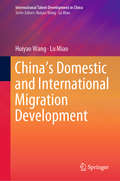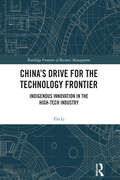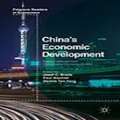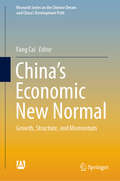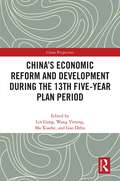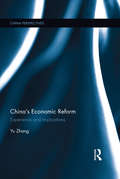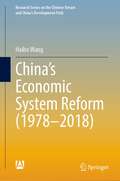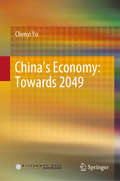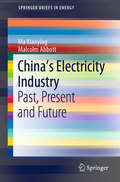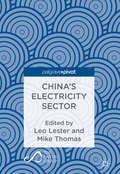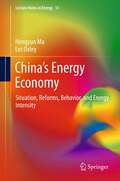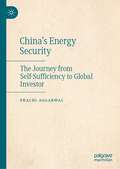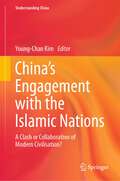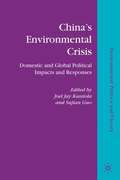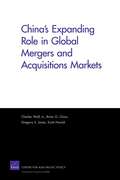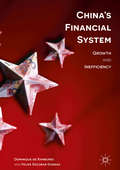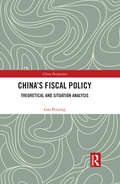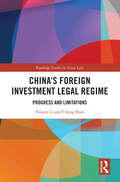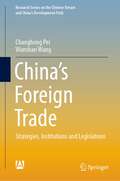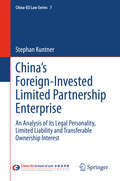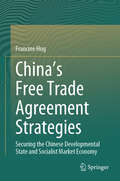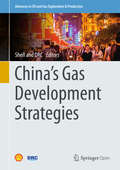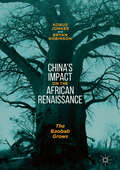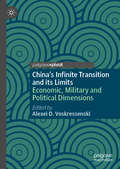- Table View
- List View
China’s Domestic and International Migration Development (International Talent Development in China)
by Lu Miao Huiyao WangThis book offers the most comprehensive, up-to-date assessment of China’s domestic and international migration. Restructuring economic development requires large numbers of educated and skilled talents, but this effort comes at a time when the size of China’s domestic workforce is shrinking. In response, both national and regional governments in China have been keen to encourage overseas Chinese talents and professionals to return to the country. Meanwhile, the Chinese government has initiated a number of policies to attract international highly-skilled talents and enhance the country’s competitiveness, and some Chinese policies have started attracting foreign talents, who are coming to the country to work, and even to stay. Since Chinese policies, mechanisms, and administration efforts to attract and retain skilled domestic or overseas talents are helping to reshape China’s economy and are significantly affecting the cooperation on migration and talent mobility, these aspects, in addition to being of scholarly and research interest, hold considerable commercial potential.
China’s Drive for the Technology Frontier: Indigenous Innovation in the High-Tech Industry (Routledge Frontiers of Business Management)
by Yin LiChina has become an innovation powerhouse in high-tech industries, but the widely held view assumes the Chinese model is built on technological borrowing and state capitalism. This book debunks the myths surrounding the Chinese model with a fresh take on China’s strategies for technological innovation. The central argument is that indigenous innovation plays a critical role in transforming the Chinese high-tech industry. Like any successfully industrialized nation in history, indigenous innovation in China allows industrial enterprises to assimilate knowledge developed elsewhere, utilize science and technology resources and human capabilities accumulated in the country, and eventually approach the technological frontier. The question is, how do Chinese businesses and governments engage in indigenous innovation? Employing the "social conditions of innovative enterprise" framework developed by William Lazonick and colleagues, this book analyzes how the interaction of strategy, organization, and finance in leading Chinese high-tech firms underpinned by national institutions enables indigenous innovation with Chinese characteristics. It features detailed case studies of two critical high-tech industries—the telecom-equipment industry and the semiconductor industry—and within them, the business histories of leading Chinese innovators. The in-depth look into China’s experience in indigenous innovation provides valuable lessons for advanced and emerging economies.
China’s Economic Development
by Paul Wachtel Josef C. Brada Dennis Tao YangThis essential reader brings together a collection of influential contributions on China's economic development, which first appeared in the Palgrave journal Comparative Economic Studies. Each chapter has been carefully selected for the contribution it has made to furthering the understanding of China's unique path to development. Topics covered include: public infrastructure, urbanisation policy, industrial policy, monetary policy, agricultural crisis and land reform. It is essential reading for professionals, scholars and researchers interested in China and economic development.
China’s Economic New Normal: Growth, Structure, and Momentum (Research Series on the Chinese Dream and China’s Development Path)
by Fang CaiThis timely volume on China’s economic “New Normal” features articles by leading scholars from the Chinese Academy of Social Sciences and other research institutions across the country. A broad range of perennial as well as hot-bottom topics related not just to economic growth but also to its social and political ramifications are covered, including patterns of growth, income distribution, domestic consumption, the global economic dynamics, and policy responses to these and other developments. Contributors not only combine theoretical and empirical analyses of these critical issues but also examine the historical background and the social context to what may be one of the most significant developments not just for China but also for the rest of the world.
China’s Economic Reform and Development during the 13th Five-Year Plan Period (China Perspectives)
by Lin Gang"Five-Year Plans" have been a cornerstone of Chinese social and economic development initiatives since 1953. During the thirteenth of these periods between 2016 and 2020, the global economy has experienced instability after the financial crisis, as well as political and economic reconfiguration. Drawing on modern economic theory, this book comprehensively discusses China's economic development in this crucial phase. The book analyzes the international economic environment, and asks how China’s continued reform and opening-up can fit with the new era of economic globalization. It also presents the difficulties China faces in such fields as urbanization, the coordination of regional development and urban-rural integration, economic reform, and the reform of factor markets and state-owned enterprises. The book outlines many medium-term development rules along with key characteristics of China's economy, helping international readers fully understand likely future trajectories for the Chinese economy.
China’s Economic Reform: Experience and Implications (China Perspectives)
by Zhang YuChina’s growth miracle over the past 30 years has propelled it to become the world’s second largest economy and potentially the largest in the following years. This book examines China’s experience on economic reform, trying to find the reasons for the sustainable and rapid development and provide insights into the study of economic theories. From the perspective of political economics, this book elaborates on China’s socialist market economy which was officially confirmed as the goal of the country’s economic reform in 1992. It expounds on China’s economic model, the relationship between socialism and market economy, as well as the establishment and improvement of socialist market economy in China, deepening the studies in the laws governing China’s economic development. Then, it explores the gradual reform, the reform of state-owned enterprises, and the relationship between governments and market, all of which are crucial to the success of China’s economic reform. Finally, based on the analysis above, this book discusses the reasons for the constant and rapid development of China’s economy. With detailed analysis on the reform experience and theoretical implications, this book will appeal to scholars and students studying China’s economy, and contribute to the development of economic theories.
China’s Economic System Reform (Research Series on the Chinese Dream and China’s Development Path)
by Haibo WangThis book analyzes and summarizes the process and achievements of China's economic restructuring from 1978 to 2018, including the objectives of China's economic restructuring, the initial stage of market-oriented reform (1979–1984), the comprehensive development stage of market-oriented reform (1985–1992), and the initial establishment stage of market-oriented reform system (1993–2000). The book illustrates the achievements and significance of China's economic system reform during the stage of system improvement (2001–2011) and the stage of comprehensive deepening reform focusing on market-oriented reform (2012–2018). It has great international significance to summarize the experiences of China's economic restructuring, and it is conducive to continuing the reform and achieving the final victory of the reform.
China’s Economy: Towards 2049
by Chenyi YuThis book is a faithful record of China’s economy that spans almost 70 years. Starting from 1949, it portrays in a panoramic picture how the economy has developed over these decades. From the initial restoration and retrenchment, to the great leap outward that resulted in the two phases of economic reform; from its accession to the WTO to the unprecedented process of urbanization, the book uses four chapters to depict in a chronological order how China becomes what it is today. For scholars on modern Chinese economy, this book offers a detailed account of a wide range of events that happened during clearly-divided time periods. On this basis, they can deepen their research on different individual subjects. Teachers of universities and colleges may use this book as a reference when preparing relevant courses. For economics majors, this book is a key that helps them clarify important issues. Learners who are interested in knowing more about China, especially the dramatic changes that have taken place in its economic scene, can equally acquire the needed facts and figures.
China’s Electricity Industry: Past, Present and Future (SpringerBriefs in Energy)
by Malcolm Abbott Ma XiaoyingThis book provides a comprehensive account of the electricity industry in China, the world's largest power producer and carbon emitter. The authors describe the historical development of China’s energy sector and study the structure and economics of the industry. Furthermore, the book studies the impact of China’s substantial demand for coal, oil and natural gas on world energy markets and discusses future trends and reforms, such as the introduction of renewable energy sources. This book will appeal to anyone interested to broaden their knowledge on the past, present and future of Chinese electricity industry.
China’s Electricity Sector
by Mike Thomas Leo LesterThis book provides a concise introduction to China’s electricity sector, suitable for university students and business analysts. It is business focused, combining an introduction from an established regional electricity consultancy with five academic chapters covering governance, market stakeholders and reform, wind and solar power, environmental regulation, and developments in financing. It is written in an accessible but rigorous style for people with limited knowledge of the topic, with minimal jargon but full referencing throughout the academic chapters. Each academic chapter starts with a summary and three key points to guide the reader’s understanding.
China’s Energy Economy: Situation, Reforms, Behavior, and Energy Intensity (Lecture Notes in Energy #13)
by Les Oxley Hengyun MaIn the new millennium, understanding China's energy economy is crucial for politicians, businesspeople and energy economists, as China's energy policy choices will mean both challenges and opportunities for the world in terms of an increasing share of primary energy consumption and investment. This book initially reviews the literature on China's energy economy and in so doing reveals that many important areas have been overlooked or are outdated in their coverage. Given the size of China and its global importance, the book then review s China's current energy situation and fills the gaps in the literature for those who are interested in and concerned about China's economic development and energy reform in the new millennium. The book is different from previous studies in several important ways: Firstly, it presents recent, pioneering research rather than a simple textbook, several sections of which have been published in high-quality energy journals. Secondly, the book first subdivides China's energy intensity change into aspects of budget constraint, technological change, factor substitution, energy demand and economic growth using a newly developed econometric approach. Thirdly, it provides many new and different econometric findings and derives many new policy implications for China's energy economy. And lastly, it brings to light a wealth of new knowledge for those who are interested in China's energy economy, the world energy market and global environmental and climate change issues.
China’s Energy Security: The Journey from Self-Sufficiency to Global Investor
by Prachi AggarwalThis book evaluates China’s energy diplomacy across the globe and how it transcends the barriers to maintain both its security and its Chinese characteristics. How China graduated from 'self-sufficiency' to 'Go out' policy. How will China’s energy security evolve within the ambit of Chinas new normal? For China, its energy security has been of primary importance, both domestically and internationally. This book explores the foreign dimension. The energy security in the Mao era was a necessity, a policy in the Deng era and a strategy in the period henceforth. The book identifies the evolution of China from a manufacturer to an investor, that is, its outbound direct investments in the energy field and the shift in its focus from traditional fuels to renewable energy sources. It goes beyond the traditional choices of energy like West Asia and Africa and explore the lesser suppliers who could have a stronger say in the future to come.
China’s Engagement with the Islamic Nations: A Clash or Collaboration of Modern Civilisation? (Understanding China)
by Young-Chan KimThis book provides a critical insight into China's evolving socio-cultural relations with Islamic countries in the face of growing geopolitical uncertainty. It considers both the historical and socioeconomic aspects of China-Islamic countries relations to present a balanced analysis of the effectiveness of the Belt and Road Initiative (BRI) plan and the current and future evolution of cooperation. The book also sheds new light of the impact on individual economic sectors, considering both the micro- and macro-effects on various stakeholders as the global community navigates an increasingly precarious power struggle between dominant world powers. The book presents contributions from a variety of fields to provide a multi-faceted breakdown of the challenges that remain for the myriad of relationships in the years to come.
China’s Environmental Crisis
by Sujian Guo Joel Jay KassiolaThis path-breaking collection covers the significance of China's extreme environmental challenges for both Chinese society and the world, how these challenges are impacting domestic Chinese society and its political institutions, and how these institutions are responding in their efforts to address the environmental problems.
China’s Expanding Role in Global Mergers and Acquisitions Markets
by Brian G. Chow Gregory S. Jones Charles Wolf Jr. Scott HaroldThe authors evaluate the risks and benefits of increased Chinese foreign investment, aiming to improve understanding of its investment patterns and strategy. They consider how U.S. national security might be compromised as well as how the United States and China can benefit from such investment, providing a way to assess national security risks and benefits and examining Chinese investment patterns in both the United States and elsewhere.
China’s Financial System: Growth and Inefficiency
by Felipe Escobar Duenas Dominique De RamburesThis book examines the volatile landscape of the Chinese economy and the barriers to its continuing development. The author argues that underlying inefficiencies in China’s financial system currently prevent the further growth of its institutions and inhibit reform of monetary and fiscal policy. Rambures shows that, despite efforts to avoid a “middle income trap”, such long-overdue structural reforms are still faced with strong resistance from both economic and political circles. Chapters discuss approaches in tackling the Chinese national debt, the recent stock exchange collapse and subsequent currency devaluation, declining trade surplus, the wariness of foreign investors and its negative impact on foreign exchange reserves, and the heavy burden of state-owned “zombie companies”. The discussion positions current economic events within the context of China’s transition from a foreign trade and investment-led economy to one that is propelled by domestic consumption, service industries and innovation. Crucially, Rambures also addresses financial trends with reference to pervasive long-term influencing factors such as an ageing population, increasing inequality, corruption, pollution and migration.
China’s Fiscal Policy: Theoretical and Situation Analysis (China Perspectives)
by Gao PeiyongFiscal policy has always been a primary measure of macroeconomic control. The fiscal revenue and expenditure can influence the operation of the whole economic and social activities by changing the existing GDP distribution pattern, affecting the consumption and investment of enterprises and people, etc. Within the framework of macroeconomic analysis, this book reviews the evolution of China’s fiscal policy, and the main changes China’s economy has experienced since 1990s. To begin with, it makes an empirical research of China’s national debts, including their relationship with macroeconomic regulation and total social demand. Besides, it examines the economic effect mechanism of national debts issuance. Then it focuses on the taxation issues, elucidating the sources of tax revenue growth and the judgments on tax burden. The issue of tax reduction is also covered, especially its complexity in China. Lastly, it provides insights into China’s fiscal tendency, changes of macroeconomic policies, and financial operation in the context of the "New Normal". Scholars and students in economics, finance and Chinese economic studies will be attracted by this book. Also, it will appeal to readers interested in modern Chinese economic history.
China’s Foreign Investment Legal Regime: Progress and Limitations (Routledge Studies in Asian Law)
by Yuwen Li Cheng BianChina has developed a piecemeal pattern of regulating foreign investment since the end of 1970s. The latest law is the Foreign Investment Law (FIL), which became effective on 1 January 2020. The groundbreaking new FIL is well acknowledged for its promises and affirmations pledged to investors, signalling China’s eagerness to improve its investment environment and regain momentum for investment growth. This book provides an updated and holistic understanding of the key features of the regulatory regime on foreign investment in China with critical analysis of laws and their implementation. It also examines sensitive and complex legal issues relevant to foreign investment beyond the 2020 FIL and new developments on foreign-related dispute settlement. The book uses cases of success and failure to illustrate the nuances and differences between law and practice regarding foreign investment. Considering China’s magnitude in the global economy and the weighty role of the regulatory system on foreign investment in China, this book is of great interest to a wide range of audience including academics in the field of investment law, legal practitioners, policymakers, and master's students in law and in management.
China’s Foreign Trade: Strategies, Institutions and Legislations (Research Series on the Chinese Dream and China’s Development Path)
by Changhong Pei Wanshan WangThis book is a full review of China's foreign trade in the past 70 years of institutional changes and reform. It presents a magnificent historical overview for China's economic history, sometimes full of trials and hardships, while facing the growth and rise. The author aims to build a unique narrative system to analyze the success and failure, gain and loss during the period, and present the China path in foreign trade among numerous events and different stages under a complex context. It is a must-read book for readers who are interested in China's foreign trade during 1949–2019.
China’s Foreign-Invested Limited Partnership Enterprise: An Analysis of its Legal Personality, Limited Liability and Transferable Ownership Interest (China-EU Law Series #7)
by Stephan KuntnerSince a reform in 2010, foreign investors can establish a Foreign-Invested Limited Partnership Enterprise (FILPE) in China together with Chinese or foreign investors. The FILPE can be combined with a domestic or foreign corporate general partner, thus allowing for a structure that offers the flexibility and taxation conditions of a partnership while protecting its investors against personal liability like a company. The book explores from the perspective of a foreign investor if the FILPE is an attractive investment vehicle by analysing whether it provides the characteristics that are internationally recognized as constituting a standard corporate form. Among these characteristics, the three that are most strongly interconnected and interdependent form the core of the analysis: legal personality, limited liability and transferable ownership interest. These are analyzed in context of China's restrictive framework of foreign investment regulations and enterprise organization law.
China’s Free Trade Agreement Strategies: Securing the Chinese Developmental State and Socialist Market Economy
by Francine HugThis book delves into the intriguing paradox of China's position in international trade law. Although China is an active member of the World Trade Organisation (WTO) engaging in substantial trade, tensions with trading partners may also arise. In this context, the book explores the legal principles informing Chinese Free Trade Agreements (FTA) and aims to answer the pivotal question: What drives China's FTA strategies? With unique analytical methods and a novel theoretical framework, this book sheds light on China's FTA strategies, challenging prevailing notions about State intervention in the economy and offering a nuanced perspective on China’s position in the world trading system. By exploring how Chinese FTAs align with developmental State and socialist market economy principles, the book contributes significantly to the fields of international economic law generally, and Chinese law specifically. Readers, especially those interested in international trade law and China's economic policies, will benefit from gaining a deeper understanding of the principles guiding China's FTA strategies and their contrast with leading liberal regimes like the WTO, the United States, and the European Union. This thought-provoking and pioneering book presents a fresh perspective on China's role in the global trade landscape. It is thus an essential resource for anyone curious about the interaction between China’s distinctive political economy and the transforming international economic order.
China’s Gas Development Strategies (Advances in Oil and Gas Exploration & Production)
by Shell International Ltd The Development Research CenterThis book is open access under a CC BY 4.0 license. This book examines how China can increase the share of natural gas in its energy system. China’s energy strategy has global ramifications and impact, and central to this strategy is the country’s transition from coal to gas. The book presents the culmination of a two-year collaboration between the Development Research Center of the State Council (DRC) and Shell. With the Chinese government’s strategic aim to increase the share of gas in the energy mix from 5.8% in 2014 to 10% and 15% in 2020 and 2030 respectively, the book outlines how China can achieve its gas targets. Providing both quantifiable metrics and policy measures for the transition, it is a much needed addition to the literature on Chinese energy policy. The research and the resulting recommendations of this study have fed directly into the Chinese government’s 13th Five-Year Plan, and provide unique insights into the Chinese government and policy-making.Due to its global impact, the book is a valuable resource for policy makers in both China and the rest of the world.
China’s Impact on the African Renaissance: The Baobab Grows
by Kobus Jonker Bryan RobinsonThis book provides the first comprehensive academic study of what China's trade with, and investment in, African countries mean for the socio-economic well-being of the continent. Based on the African Tree of Organic Growth Framework developed in the book, Jonker and Robinson outline the factors necessary in realizing Africa's Renaissance vision and the impact that the Chinese might have on this process. Using the metaphor of the Baobab tree, the authors analyze the historical, cultural and economic contexts within African countries, the channels available to produce development and growth, and the fruits or social and economic well-being created by this integrated process. The book takes readers on a journey of numerous African examples and case studies, describing and analyzing the challenges and complexities of countries in their desire to achieve organic, cultural, scientific and economic renewal, and the improvement of the well-being of their citizens. This book will be of great value to economists, people who wish to do business in Africa, China-watchers, those who are following the development and growth of Africa, and more.
China’s Infinite Transition and its Limits: Economic, Military and Political Dimensions
by Mikhail Karpov Vasily KashinThis book examines the Chinese model of modernization in three key fields – economic, political and military. The explanations provided here, prepared by Russian analysts, are original because of the authors’ first-hand knowledge of China and their unique professional experience. They share essential insights on China’s model of modernization and its connections to both policy and practice. Focusing on the most vital issues surrounding modernization, and on its impacts on the most important spheres in China, the book offers a valuable asset for the analytical and policy-making community.
China’s Innovation Challenge
by Martin Kenney Martin Arie Y. Lewin Johann Peter Murmann Lewin Arie Y. Kenney Murmann Johann PeterThe miracle growth of the Chinese economy has decreased from a compound annual growth rate of 10% to less than 7% in 2015. The two engines of growth - export on a scale never before witnessed and massive infrastructure investments - are reaching the point of diminishing returns. This poses the central question which is explored in this book - can China escape the middle-income trap? Assuming current political arrangements remain unchanged and that it does not or cannot adopt Western sociopolitical economic regimes, can China develop an indigenous growth model centered on innovation? This compilation gathers leading Chinese and other international scholars to consider the daunting challenges and complexities of building an innovation-driven Chinese growth model. Providing several comprehensive perspectives, it examines key areas such as the institutional system, technology, sociocultural forces and national policy. The analyses and their conclusions range from strong optimism to deep pessimism about China's future.
